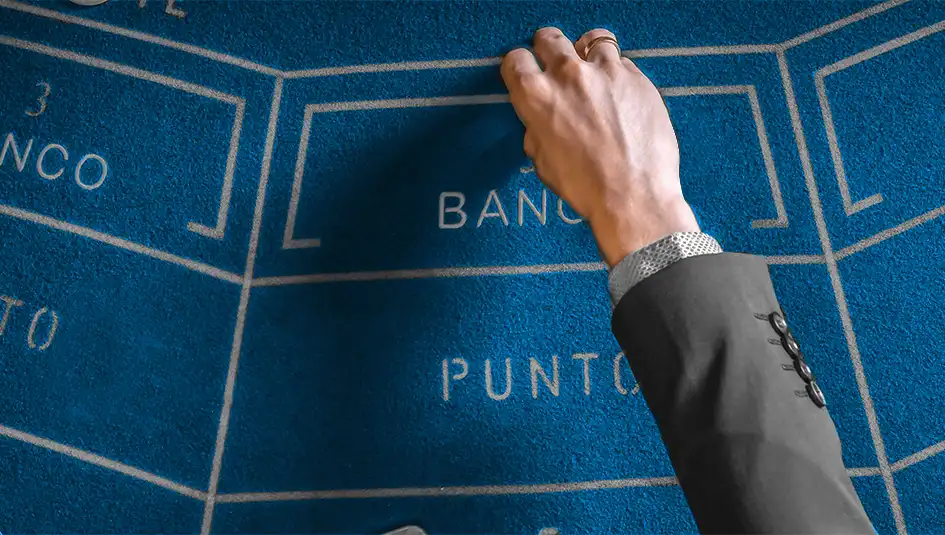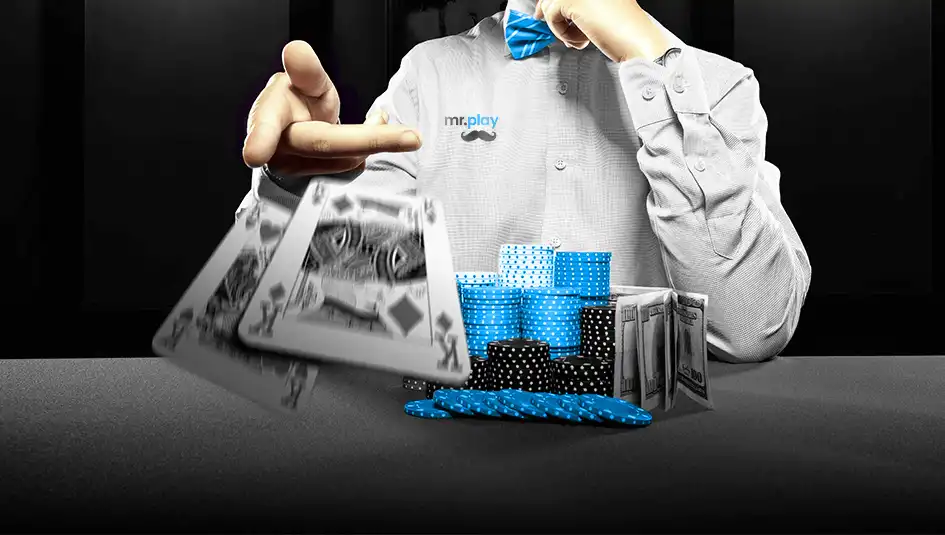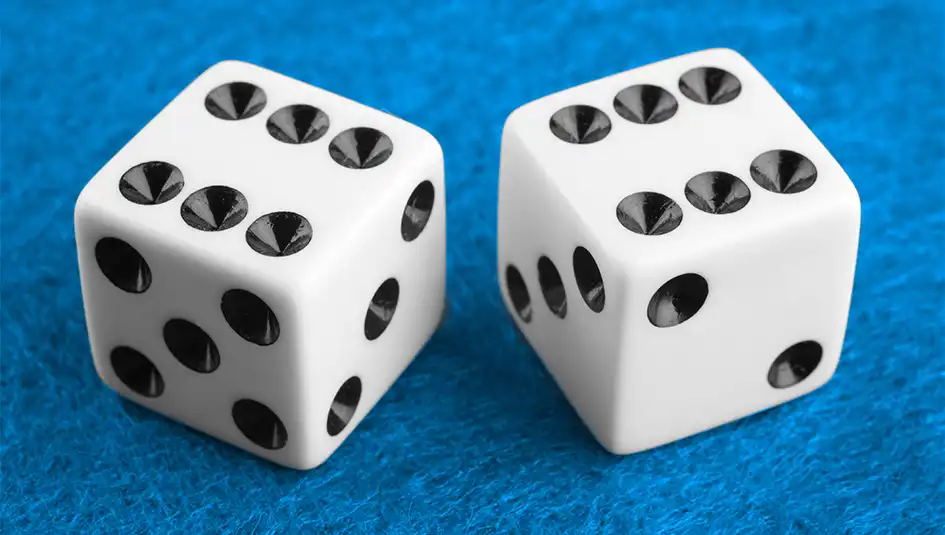How to Play Punto Banco
The aim of Punto Banco is to bet on which one of two hand positions, player or banker, will have a score closer to 9 at the end of the round. The score of a hand is calculated by totalling the value of the cards in it. Aces are worth 1, the number cards 2 to 9 are worth their face while 10s, Jacks, Queens, and Kings are worth 0 points. If the sum of the cards in a hand is greater than 9, then ten is subtracted from the total. For example, a hand of 12 is worth 2.
In most versions of the game, a shoe of eight decks is used, but some games use six decks. At the start of a round, players will bet on player, banker or a tie. The dealer then deals two cards face down to each position. The cards are then turned over and the hands’ scores revealed. Depending on the hand score, a third card may be dealt to a hand.
The following rules apply to the player hand:
- If the hand has a score of 0 to 5 then a third card is dealt
- If the total is six or seven then the hand stands
- If the hand is a small natural (8) or a big natural (9), then the player wins.
The rules for the banker hand are a bit more complicated as the rules governing a third card depend not only on the initial cards, but also on the third card dealt to the player:
- If the banker hand has a score of 0 to 3 then a third card is always drawn, regardless of the player hand.
- If the banker hand has a score of 4, then a third card is drawn if the player hand is worth 2 to 7.
- If the banker hand has a score of 5, a third card is drawn if the player hand is worth 4 to 7.
- If the banker hand has a score of 6 and the player hand is 6 or 7, then a third card is drawn only if the player hand has already drawn a third card and the total has been made with three cards.
- The banker always stands if the hand is worth 7, 8 or 9.
After all the cards have been dealt, players are paid out for winning bets. A winning player bet pays at 1:1, a winning banker bet pays at 0.95:1 (because of a 5% commission taken by the casino), and a winning tie bet pays at 8:1. In many versions of the game, in the event of a tie, player and banker bets are left on the table for the next round.
Punto Banco Tips
As should be clear, Punto Banco is purely a game of chance. There is no skill involved and there is nothing that the player can do to influence the outcome of a round. However, this does not mean that there is nothing you can do to try to improve your returns. There are some basic strategies that you can adopt that will help you on the way to success.
To start with, you should carefully consider whether you are going to bet on the player or banker. While at first glance it may seem that there is a 50/50 chance of winning either bet, due to the rules governing the third card this is not actually true. Statistically, there is a slightly better chance of the banker winning, and that is why the casino deducts a 5% commission from winning banker bets. However, this does not mean that you should never use the player bet as a successful player bet provides bigger winnings.
The Tie bet also deserves careful consideration. It is a very attractive bet as it offers far bigger returns of 8:1. However, there is less than a 10% chance of a round ending in a tie, which means that there is a huge house edge. Once again, this does not mean that you should never use this bet. As long as you are properly managing your bankroll, there is no reason that you cannot take the risk occasionally and try to secure the bigger payout.
Punto Banco Strategy
There is a very simple Punto Banco strategy that is very popular with players. It will not guarantee that you will win, but when used properly, it may help to reduce your losses and ensure that you are able to keep playing for longer.
As noted, statistically the banker bet has a better chance of winning. Therefore, it is always a good idea to start the game by betting on the banker. If you win the bet, then you can place it again, and keep placing it until the banker loses.
It is inevitable that the banker will eventually lose, and at this point, many people will have the natural urge to switch to the player bet. However, it is a good idea to avoid doing so. Stay with the banker for one more round and if the Player wins again, then you can switch to the player bet. Otherwise, keep betting on banker. If a round ends in a Tie, then you can consider it as a Banker win for the purpose of this strategy. If you are betting on the player and the banker wins, then you should immediately switch back to betting on the banker.
Ultimately, as this strategy demonstrates, it is always better to place banker bets, even with the 5% commission that the casino takes. At the same time, you should be very careful about managing your bankroll. If you know that you want to play for an hour and you know that there will be roughly 50 rounds in an hour, then you need to make sure that you can afford to bet on 50 rounds. For example, if you have a budget of €100, then don’t bet more than €2 per hand. This way, you can be sure that you won’t run out of funds. While it is highly unlikely that you will lose all 50 rounds, when planning your budget, it is safer to assume that you will.
Punto Banco Betting Systems
Betting systems are an excellent tool for those who want to make life a little more interesting than just betting the same amount on each hand while still managing their bankroll carefully. There are a number of well-known betting systems, and many of them can be used very successfully with Punto Banco.
For example, the Martingale System is probably the best known betting system of them all. The system is very simple and easy to remember, it just calls for you to double your bet after a losing round. For example, if you have placed a €10 bet on the banker and it loses, then the next round you would bet €20 on the banker. If that hand loses, then sticking with the strategy described above, you would then bet €40 on the player. The obvious disadvantage here is that the bets can become very big if you hit a losing streak. However, once you win a hand, you will recuperate nearly all of your losses.
Another very well known system is the Paroli, which is sometimes called the Reverse Martingale, as it is the exact opposite of it. The system says that you should double your bet every time that you win until your lose. The aim is to try to land three wins in a row. For example, you bet €10 on the player and win, you then double it to €20 and you win, and then you double it to €40 and lose. In the next hand, you would return to a €10 bet on the banker.
A third system is the Fibonacci. As the name suggests, it is based upon the natural number sequence in which the next number in a progression is the sum of the previous two. For example, 1, 2, 3, 5, 8, 13, 21, 34, 55, and so on. The system says that for every bet that you lose, you should increase it in the next round, and then you keep going until you hit a win. Each time you increase your bet, you multiple it by the next number in the Fibonacci sequence. For example, if you start with a bet of €10 on the player and lose the first two rounds, then your third bet will be €30 (3 x €10). If you then lose again, the next bet would be €50. If you are lucky enough to win, then the returns will cover the losses from the previous two rounds. At this point, you return to the original bet of €10.
A more complicated system is the Labouchere, and it is also known as the American Progression, the Cancellation System, and the Split Martingale. The system requires you to increase your bet after every loss. You first need to create a sequence, it can be anything you wish, but for simplicity let’s use the example of 1-2-3-4. You then bet the amount equal to the sum of the last and first numbers in the sequence, which in this case would be €5 (1+4). If your bet wins, then you remove the first and last numbers from the sequence, which leaves a sequence of 2-3. This means that your next bet would be €5 (2+3). You keep repeating this process for as long as you are winning. When there are no numbers left in the line, you can then start again. However, if you lose a bet, then you do not cross any numbers off. Rather, you add the amount you just bet to the right hand side of the line. Sticking with this example, if you lost your first bet the line would become 1-2-3-4-5. You then start the process again.

 A Beginner’s Guide to Caribbean Stud Poker
A Beginner’s Guide to Caribbean Stud Poker A Beginner’s Guide to Sic Bo
A Beginner’s Guide to Sic Bo